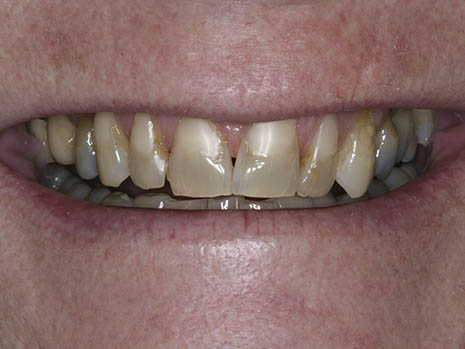
Tooth stains that don’t bleach
Do you have tooth stains that don’t bleach? With today’s advanced cosmetic dentistry treatments, most smile concerns can be improved effectively and efficiently. For instance, if your teeth are stained, then you may be able to brighten them with professional teeth whitening. However, if your teeth have more stubborn discolorations than usual, then you may need a more involved cosmetic enhancement to improve their appearance. We provide a variety of other customized cosmetic dentistry procedures to help you get whiter teeth. Often it can be done with less invasive dental work such as tooth bonding or teeth veneers. We actually start with learning about the toothbrush, how to properly use it, and how to floss.

This tooth discoloration is not appropriate for whitening. The intrinsic stains are deep into the dentin and large portions of the teeth are covered with composite which will not change color. Any whitening of the natural tooth structure will cause the fillings to stand out.
Common Types of Dental Stains
Before we talk about how to remove surface stains, let’s explore the two most common types of tooth stains.
Extrinsic Tooth Stains
Common teeth stains develop on the surface of your teeth (known as extrinsic staining). They can often be caused by exposure to food and beverages, or by things like tobacco use and alcohol consumption. Things like red wine, coffee, tea, berries, and other dark colored foods can exacerbate the condition. Because extrinsic stains form on your tooth surfaces, they can typically be erased with simple hydrogen peroxide based teeth whitening treatments. The bleaches will break up and remove the molecules and deposits that cause staining.
Dr. Fondriest offers dentist supervised at home whitening at our Chicago practice. This teeth whitening treatment can effectively brighten your smile and is much safer than over the counter bleaching products. Some store bought brands can be too harsh and abrasive for the enamel. Many whitening toothpastes are filled with abrasives.
In office whitening gels, which brighten teeth in as little as 45 minutes, actually works by dehydrating the teeth. The results are short-lived, and bleaching trays must be used to fully eliminate staining. Furthermore, in office whitening can actually irritate the gum tissue and the tooth pulp. For these reasons, he only offers at home whitening with Nite White Excel 3 from Discus Dental.
Intrinsic Stains
Sometimes, teeth stains can develop within the dentin, the layer beneath the tooth enamel. These are typically the tooth stains that don’t bleach with whitening strips, simple whitening kits, or even.the strongest bleaching agents Known as intrinsic staining, this type of blemish generally won’t respond to teeth whitening or improving oral hygiene. This type of dark coloration can be caused by a number of factors including some medications such as tetracycline and certain antihistamines, antidepressants, and hypertension drugs. Trauma can also cause bleeding to occur inside the tooth. As a result, the tooth becomes permanently darkened. Unfortunately, intrinsic stains do not respond to teeth whitening and must be addressed with other cosmetic dentistry treatments.
Sometimes the enamel has been lost due to erosion. If this is the case, the teeth will not bleach.
Cosmetic Dentistry Treatments for Tooth Stains that Don’t Whiten
When bleaching products don’t work on your tooth stains, dental professionals may recommend a more appropriate option. You want to have a safer way to whiten your teeth. In the sections below, we’ll explore some of the most common cosmetic dentistry treatments for yellow teeth.
Cosmetic Bonding
Cosmetic tooth bonding involves placing and polishing custom tinted, tooth colored composite resin on the stained tooth. Tooth bonding can restore your stained teeth to beauty with minimal changes to your tooth structure.
To perform this treatment, Dr. Fondriest applies composite resin to the surface of the tooth. He then shapes and molds the material to conceal the darkness. Next, he uses a special curing light to harden the material. Carefully adding layers until the desired result is achieved, he finally polishes the tooth to a natural looking shine. Dental bonding usually lasts about five to seven years on average.
Porcelain Veneers
To treat severe cases of tooth stains that don’t bleach, your dentist might recommend porcelain veneers. They can be placed on the front surfaces of one or more teeth to provide an instant smile makeover. While dental bonding involves applying liquid composite, veneers are actually thin (but strong) custom made ceramic shells. They must be fabricated in a dental lab according to your unique oral anatomy. Even the shading of the porcelain can be customized precisely to match the surrounding teeth.
Before the lab can make the veneers, the teeth must be prepared and impressions must be taken. To do this, Dr. Fondriest removes small amounts of enamel from the teeth surfaces. This improves the bonding area and makes room for the restorations. Next, the impressions are taken and the images are sent to a trained dental technician. Once he or she has finished your veneers, they are shipped to our office for placement. Dr. Fondriest will assess the size, shape, and color of your veneers before bonding them permanently into place.
Porcelain Crowns to cover the tooth stains that don’t whiten
If staining is accompanied by weak tooth structure, Dr. Fondriest may recommend a porcelain crown. This type of restoration is used to rebuild a tooth damaged by a fracture or decay. Our all porcelain crowns can be customized to blend in with your smile for a seamless look. Advanced dental materials even mimic the translucency of natural enamel, so today’s restorations are difficult to tell from your natural teeth.
Combining Whitening with Bonding, Crowns, and Veneers
Some patients may have a combination of extrinsic and intrinsic staining. Whenever you’re combining whitening with custom restorations, it’s important to whiten first. After your teeth have been lightened to the desired shade, we can make custom restorations to give you dazzling white teeth.
Learn more about tooth stains that don’t bleach and what to do
One new motivator to improve your smile is a new published study that connects smiling to professional success. Teeth whitening products can erase the most common teeth stains from foods and drinks, but certain types of stains won’t respond to the procedure.
